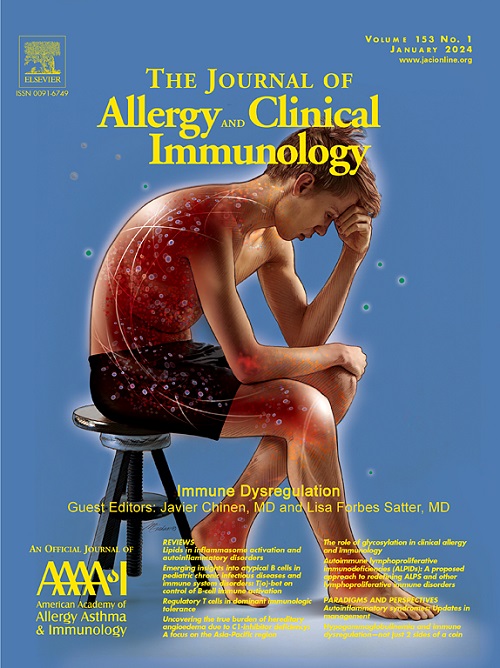Esophageal epithelial Ikkβ deletion promotes eosinophilic esophagitis in experimental allergy mouse model
IF 11.4
1区 医学
Q1 ALLERGY
引用次数: 0
Abstract
Background
Eosinophilic esophagitis (EoE) is a chronic TH2-associated inflammatory disorder triggered by food allergens, resulting in esophageal dysfunction through edema, fibrosis, and tissue remodeling. The role of epithelial remodeling in EoE pathogenesis is critical but not fully understood.
Objective
We investigated the role of epithelial IKKβ/NF-κB signaling in EoE pathogenesis using a mouse model with conditional Ikkβ knockout in esophageal epithelial cells (IkkβEEC-KO).
Methods
EoE was induced in IkkβEEC-KO mice through skin sensitization with MC903/ovalbumin followed by intraesophageal ovalbumin challenge. Histologic and transcriptional analyses were performed to assess EoE features. Single-cell RNA sequencing was used to profile esophageal mucosal cell populations and gene expression changes.
Results
IkkβEEC-KO/EoE mice exhibited hallmark EoE features, including eosinophil infiltration, intraepithelial eosinophils, microabscesses, basal cell hyperplasia, and lamina propria remodeling. RNA sequencing revealed significant alterations in IKKβ/NF-κB signaling pathways, with decreased expression of RELA and increased expression of IKKβ-negative regulators. Sequencing analyses identified disrupted epithelial differentiation and barrier integrity alongside increased type 2 immune responses and peptidase activity.
Conclusion
Loss of epithelial IKKβ signaling exacerbates EoE pathogenesis, highlighting the critical role of this pathway in maintaining epithelial homeostasis and preventing allergic inflammation. The IkkβEEC-KO/EoE mouse model closely mirrors human EoE, providing a valuable tool for investigating disease mechanisms and therapeutic targets. This model can facilitate the development of strategies to prevent chronic inflammation and tissue remodeling in EoE.
食管上皮Ikkβ缺失促进实验性过敏小鼠模型嗜酸性食管炎。
背景:嗜酸性食管炎(EoE)是一种由食物过敏原引发的慢性辅助性T型2 (Th2)相关炎症性疾病,通过水肿、纤维化和组织重塑导致食管功能障碍。上皮重塑在EoE发病机制中的作用至关重要,但尚未完全了解。目的:通过食道上皮细胞条件IKKβ敲除(IKKβ eec - ko)小鼠模型,探讨上皮IKKβ/NFκB信号通路在EoE发病中的作用。方法:采用MC903/Ovalbumin (OVA)致敏法诱导IkkβEEC-KO小鼠发生EoE,并在食管内激发卵清蛋白(OVA)。进行组织学和转录分析以评估EoE特征。单细胞RNA测序(scRNA-seq)用于分析食管粘膜细胞群和基因表达变化。结果:IkkβEEC-KO/EoE小鼠表现出标志性的EoE特征,包括嗜酸性粒细胞浸润、上皮内嗜酸性粒细胞、微脓肿、基底细胞增生和固有层重塑。RNA-seq显示IKKβ/NFκB信号通路显著改变,RELA表达减少,IKKβ负调控因子表达增加。scRNA-seq分析发现上皮分化和屏障完整性被破坏,同时2型免疫反应和肽酶活性增加。结论:我们的研究表明,上皮细胞IKKβ信号通路的缺失加剧了EoE的发病机制,强调了该通路在维持上皮稳态和预防过敏性炎症中的关键作用。IkkβEEC-KO/EoE小鼠模型与人类EoE非常接近,为研究疾病机制和治疗靶点提供了有价值的工具。该模型有助于制定预防EoE慢性炎症和组织重塑的策略。
本文章由计算机程序翻译,如有差异,请以英文原文为准。
求助全文
约1分钟内获得全文
求助全文
来源期刊
CiteScore
25.90
自引率
7.70%
发文量
1302
审稿时长
38 days
期刊介绍:
The Journal of Allergy and Clinical Immunology is a prestigious publication that features groundbreaking research in the fields of Allergy, Asthma, and Immunology. This influential journal publishes high-impact research papers that explore various topics, including asthma, food allergy, allergic rhinitis, atopic dermatitis, primary immune deficiencies, occupational and environmental allergy, and other allergic and immunologic diseases. The articles not only report on clinical trials and mechanistic studies but also provide insights into novel therapies, underlying mechanisms, and important discoveries that contribute to our understanding of these diseases. By sharing this valuable information, the journal aims to enhance the diagnosis and management of patients in the future.

 求助内容:
求助内容: 应助结果提醒方式:
应助结果提醒方式:


